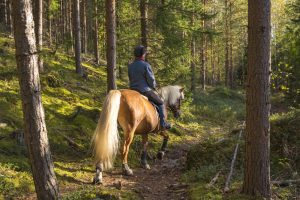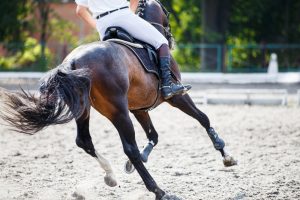Joint and other complaints in ‘horse people’
Part 1: Low back pain
In analogy with the statement that a horse is not made to sit on, it can be said that man is not made to sit on a horse. In any case, a sitting position for people is not optimal, especially because of the unusual angle at the lower back and knees. When sitting on and riding a horse, parts of the body are in a number of other unnatural angles and positions that can result in problems. Consider, for example, the well-known ‘chop down, toes inwards.’ As a result, many horsemen regularly have complaints to their bodies such as back and hip. These restrictions in turn often have a lot of influence on horseback riding and giving the right directions. Due to blockages in the lower back, the so-called deep core muscles such as abdominal and back muscles are trained incorrectly and asymmetrically, so that sitting on a horse is difficult and in particular even giving the smallest (correct) directions with for instance legs. Just as with the horse, the center of gravity of the load is on the joints and related structures of the back, pelvis and shoulder girdle. From there, there is often low back pain radiating to the legs and pain and stiffness of the structures of the shoulder girdle. Furthermore, the wrists, knees and elbows are known points of (over) load in riders. In this first part attention is paid to the most important of the (over) load complaints in ‘horse people’: the low back pain.
Low back complaints
Causes
Low back complaints have many different causes and in turn cause a large number of other complaints. When riding, the back is put through intensive strain and often overloaded due to insufficient trunk stability. Blockages in the lower back sometimes cause pain with (slight) radiation to the buttock (s) and / or leg(s). These blockages also cause a long-term obliquity with regard to the deep back and abdominal muscles. It is known that many complaints to the shoulder belt such as the known complaints of the trapezoid muscle with the most painful point (trigger point) between the shoulder blades are caused by problems in the lower back.
Horse riding and the back
Horse riding is basically not harmful to the back
Horse riding is a sport activity that offers both physical and mental health benefits and unlike some prejudices, riding is not harmful to the back when there are no existing back problems. Horse riding can boost and strengthen your self-confidence and concentration capacities. Except for people who already suffer from a back injury, riding is beneficial for the back. This sport can even correct back pain if it is caused by muscle relaxation. Because you have to sit straight on the horse, the muscles of the spine and the abdominal wall are made stronger. By learning to sit well, you develop a symmetrical and harmonious posture that promotes the health of your own back and that of the horse. The saddle also plays a major role as this can leave or even force you in a certain position. Under normal circumstances, there are usually no sudden movements with horseback riding, except for falling with or (scaring) off the horse.
Horse riding with existing back complaints
Once you have back problems you feel everything sooner and more intense and you are often very consciously occupied with yourself, because you always try to ride as pain free as possible. Back pain is after headache the most common ailment in our society. Back complaints can be roughly divided into different groups: hernia and whiplash are most well-known [2]. In addition, you can suffer from scoliosis, back problems based on muscle complaints and back complaints that occur because parts of the spine are stuck. Unfortunately, you cannot clearly say that you can drive with one back complaint and not with the other. It is entirely dependent on the situation, where it is also important to determine whether it is still real to the horse to ride it with limited physical capabilities of the rider.
Back complaints based on muscle problems
With back complaints based on muscle problems you can basically just ride. Usually it is an incidental complaint as a result of a distortion or strange movement that will disappear spontaneously. In case of a structural problem, it is wise to seek help. It is always good to get a massage, visit a physiotherapist or a sauna and try to find out what causes the muscle problems. These can also be caused by other activities than riding. It is even sensible to practice another sport in addition to riding where other muscle groups are trained. In case of extreme muscle problems, it may be good to temporarily stop riding because otherwise you might end up in a vicious circle [2].
Hernia
A hernia does not mean that your passion for horse riding has to end. As with any injury, a recovery time is needed and it can be a lesson in patience, but there is no reason why you cannot go riding again in the end. After damage to one or more intervertebral discs your body will never be completely the same as it used to be, and some adjustments will be necessary. Both during and after the recovery building strong core muscles is one of the most important things you can do to protect yourself from the recurrence of the injury. For anyone with a hernia and even for people without back problems, strong core muscles and trunk stability will protect the back while riding. In fact, even after a hernia, someone who learns good trunk stability and the correct spine alignment can strengthen his / her back and core stability by riding a horse.
Riding in itself does not entail sudden movements in principle. It is rather the related work (lifting bags of feed and bales of hay, etc.) that poses a danger to the existing hernia.
Possibly repeated shocks from riding can make underlying back pain worse. That is why it is important to always warm up (stretching) the back muscles before you mount the horse. It may be wise to wear a kind of back brace or lumbar support belt while driving. Furthermore, it may be useful to use flexible braces or stirrup straps to absorb impacts on cartilage and ligaments, reduce tension in the hips, knees, ankles and calves as well as distracted pain and reduce tension in the lower back. Choosing the right saddle can also make a big difference. If a saddle does not feel right, try another one. After the ride, a heated pad placed against the lower back can be useful.
Since pain in these back problems is also due to (low-grade) inflammations as with all soft tissue injuries, standard painkillers such as paracetamol and combination painkillers / anti-inflammatory drugs such as ibuprofen from the group of NSAIDs are prescribed. However, as indicated earlier, there is a good alternative in the form of a liquid dietary supplement of, among others, Green-lipped mussel (GLM max) variant), Bio-Curcumin (BCM-95 variant) and Blackcurrant leaf (Ribes nigrum) which is a real alternative for analgesic or anti-inflammatory drugs that are usually prescribed for low back pain.
Whiplash
With whiplash, the vertebrae in the back and neck cause problems. Any unexpected movement can cause tremendous pain and caution is advised. Often, no damage is seen on the X-rays because it often involves more damage to the soft tissues in the neck and shoulder girdle. These lead to complaints such as nausea, balance problems and double vision. In a separate piece about the shoulder belt and neck, more attention will be paid to this.
Treatment low back pain
Low back complaints are easy to treat through manual therapy and physiotherapy. Flex chair rider training helps a lot here, because it allows the deep back and abdominal muscles to be trained. In addition, these complaints are combated with pain medication (e.g. paracetamol) and combined pain and anti-inflammatory medication (e.g. ibuprofen from the group of non-steroidal anti-inflammatory drugs, NSAIDs). Since this medication gives quite a few side effects especially on the gastrointestinal tract, it is sometimes better to use alternatives. Liquid Green-lipped mussel with Bio-curcumin and Blackcurrant leaf is a promising therapy for low back pain and possibly other rheumatic diseases. This is the outcome of a recently completed clinical study [1].
The researchers compared the collected data from medical records of patients with low back pain at three time points: before the start of the treatment, after six weeks and after three months. The treatment with a liquid dietary supplement of, among others, Green-lipped mussel variant), Bio-Curcumin and Blackcurrant leaf (Ribes nigrum) caused a sharp decrease in pain in the first six weeks. This advantage lasted until the last measuring point of three months. Within six weeks of the start of treatment, the quality of life also increased significantly. The need for painkillers decreased and less help was needed in daily care, such as brushing teeth, dressing and getting in or out of bed. In addition, patients were better able to lift things. No side effects were reported. The conclusion was therefore that the supplement is a real alternative for analgesic or anti-inflammatory drugs that are usually prescribed for low back complaints.
Exercises
Step
You sit on your ischial bones and from there you follow the movements of the horse as smoothly as possible. It is important that your sitting position follows the movement of the horse’s back as much as possible while the hand has to follow the horse’s mouth [2]. Try to sit relaxed and keep the mouth – hand – wrist – elbow – shoulder as loose as possible. Keep your shoulder belt as relaxed as possible and breathe from your stomach, not your chest.
Trot
Do you have back problems? Then try to perform light riding from the leg muscles of the upper leg. Whiplash patients should learn to tilt the pelvis slightly, providing room between the vertebrae. This way, the movement can flow to the loose vertebrae that have to learn to work like a spring. This allows you to hold the upper body still without becoming cramped. This way, no extra pressure is exerted on the brackets and you learn to move your back in parts. For back patients it is wise to keep the pelvis as straight and stable as possible during sitting. Try to allow the movement of your horse to flow to your ankles and upper back, enabling those points to absorb the shocks [2].
Gallop
According to the professionals, it is desirable that you, as a back patient, let the absorbed movement flow away through your ankles or try to lift yourself with something from the saddle with your thighs, so that you are just above the saddle (elevated sitting position). This also applies to someone with whiplash complaints, for which the canter is a tricky gait. The rider should have good control over his back and its functioning. Just like in trot, you can tilt the pelvis slightly and let many of the trapped movements flow to the ankles. Relaxed, flexible hips and pelvis are important to relieve your painful neck [2]. Think of the movements that are made during salsa dancing, for example.
Sources:
[1] Qu, J.; Mélot, Ch .; Appletree, Th. (2017) Synofit Premium in refractory low back pain: a retrospective observational study. Open Journal of Rheumatology and Autoimmune Diseases 7; 120-127.
[2] Dunn, J. (2014) Driving with back pain. Bit 13 May 2014, edition 145.

Share this page
Tweet

Download for free the booklet ‘Moving without pain’ with a retail value of $6.75 / £4.95.
Any questions? Please feel free to contact us. Contact us.







